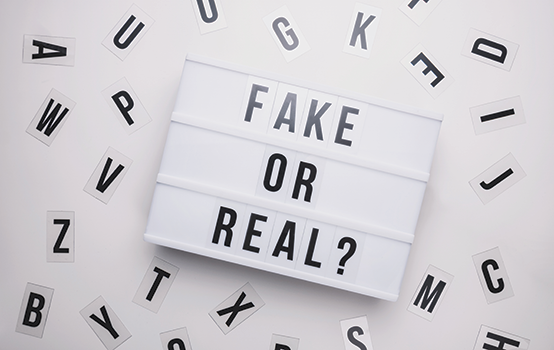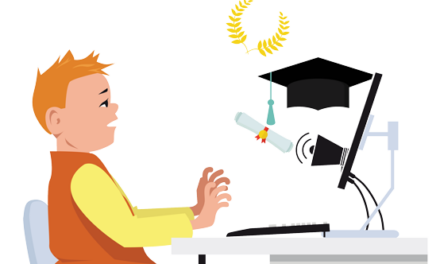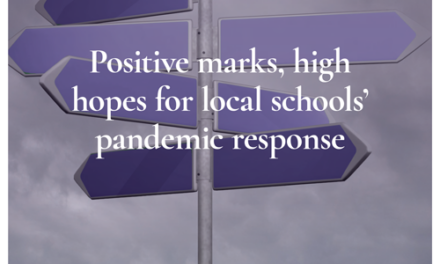Teachers need a framework to help them determine what issues are open for discussion and what evidence is worthy of consideration in the classroom.
In spring 2020, a conflict erupted across the United States over how best to respond to the COVID-19 pandemic. As state-mandated shelter-in-place orders pushed into late April 2020, “reopen rallies” began popping up in state capitals. While many protesters at these rallies were rightly concerned about the economic implications of these shutdowns on their livelihoods, interviews with attendees and photographs from these events showed that many were using faulty evidence to make their case. Among their assertions were such scientifically debunked claims as COVID-19 being no deadlier than the common flu, or the virus posing no risk to otherwise healthy people under 65 years old. Across social media, people who supported the shutdowns reacted to these protests with a mixture of disdain and incredulity, citing evidence that illustrated both the lethality of COVID-19 and the effectiveness of the shutdowns on slowing the spread of the virus.
The controversy surrounding the COVID-19 response is just one example of how political polarization has come to encompass the news Americans consume, the perspectives we encounter on social media, and even our daily interactions with our neighbors. To understand those who protest against shutdowns, one must consider what they are hearing within the media echo chambers in which they choose to reside. In the spring of 2020, these echo chambers were filled with cable news pundits, radio hosts, and politicians using scientifically dubious claims and outright falsehoods to downplay the threat of COVID-19, with some even dismissing it as a hoax perpetuated by mainstream media outlets (Bump, 2020). Many religious leaders across the United States downplayed the virus, holding services in defiance of shutdown orders and claiming that COVID-19 could be eradicated through prayer alone (Jenkins, 2020). During his daily televised press briefings, then-President Donald Trump would regularly contradict or dismiss advice given by medical professionals based solely on hunches that he had at the time (Shane, 2020).
As the reopen rallies attest, relying on information sources that ignore or contradict science and other forms of expertise can have real-world consequences. It also poses challenges to K-12 education. Students encounter much of the same misinformation that adults do, and research shows that they often bring such heavily biased or inaccurate information into classroom discussions (Segall et al., 2019). When teachers attempt to broach contested issues in the classroom, they often find themselves having to address poor information, prejudices, or beliefs that cannot be objectively evaluated.
Fortunately, the literature on teaching controversial issues offers a road map that can help teachers navigate such tensions. If they can point to clear and reasonable guidelines that explain why they will entertain some arguments but not others — including arguments that may be popular with some students and parents — then that puts them on firmer ground. They can show that they’ve been principled and fair-minded in deciding which ideas deserve to be taken seriously in the classroom, and they can protect themselves from the accusation that those decisions are politically partisan, or that they’re trying to indoctrinate students.
Determining what issues are open for discussion
One of a teacher’s most important roles is that of curricular gatekeeper (Thornton, 1991). There is not enough time in the school day or space in the curriculum to give credence to every possible opinion or disagreement; therefore, teachers have a responsibility to determine which issues and beliefs are worthy of exploring. At the same time, the open exchange of ideas is a hallmark of a democratic education, and teachers should not take the decision to silence a student’s beliefs lightly (Callan, 2011).
When teachers attempt to broach contested issues in the classroom, they often find themselves having to address poor information, prejudices, or beliefs that cannot be objectively evaluated.
Diana Hess’s delineation of “open” versus “settled” issues is helpful here (Hess, 2009; Hess & McAvoy, 2015; Richardson, 2017). According to Hess, open issues are those on which more than one rational or reasonable position can be taken, and settled issues are those on which there is only one such position. When teachers broach open issues in the classroom, all rational or reasonable positions should receive a fair hearing. With settled issues, however, teachers should avoid debates and instead provide students with the settled position and describe any competing beliefs as unreasonable.
At first glance, it may seem straightforward enough to distinguish between settled and open issues. In practice, however, that distinction can easily blur. For instance, issues often “tip” from open to settled — until the passage of the 13th Amendment, the right to enslave people was very much an open question to many Americans, but it has been a settled matter ever since. So, too, can issues tip from settled to open, and issues can even tip multiple times. To borrow an example from Hess (2009), when President Franklin Roosevelt issued the executive order to imprison Japanese Americans during World War II, it was largely a settled issue — most people agreed with the decision as a matter of national security, and the Supreme Court affirmed Roosevelt’s order. In the decades following the war, people began to question the morality of the order to the point that the legacy of Japanese American internment became an open issue. By the mid-1970s, the issue began to tip again, this time toward a settled position that Roosevelt’s executive order was immoral, a position that was cemented by multiple public apologies by the federal government and the Civil Liberties Act of 1988, which paid reparations to living survivors of the internment.
Further, just because an issue is open, that doesn’t mean all arguments about it are valid. If students make claims that lack evidence, are based solely on personal prejudice, or are otherwise unreasonable, then teachers are obligated to point that out. For example, the question of when to end shutdowns during a pandemic is an open issue; people can take very different but equally reasonable positions on what to do, and it would be appropriate to discuss those options in a classroom. But it would not be reasonable for a student to argue, in support of the idea that lockdowns should be outlawed, that COVID-19 is no more dangerous than the flu. Among the vast majority of epidemiologists and other medical experts, the severity of the coronavirus is a settled matter.
In the heat of a national debate or when passions are inflamed, it is even more important to not conflate settled and open positions. Determining the openness of issues, however, can be difficult. Unfortunately, there is no single, agreed-upon method for determining which issues are open. However, scholars have identified four criteria for making these judgments — one of those criteria is generally viewed to be faulty, and three are viewed as helpful.
An issue isn’t open just because someone contradicts it
It is instructive to begin with the criterion that scholars usually dismiss as unhelpful: the behavioral criterion, which suggests that issues should be framed as open (i.e., worthy of deliberation) if any contradictory positions exist (Bailey, 1971). The problem is that one can find a contradictory opinion to even the most settled of issues. For instance, although the roundness of the Earth has been considered scientific fact for at least 500 years, there are still some people who believe the Earth to be flat (Wolchover, 2017). Using the behavioral criterion, we would have to tell science teachers that since a few of their students believe outrageous theories about the danger of sailing off the edge of the planet, they should “teach the controversy” about the Earth’s shape — but that would be ridiculous.
Moreover, people sometimes take contradictory positions even when they know the evidence doesn’t back them up. For instance, consider the unfounded claim that President Barack Obama was born outside the United States. Even in 2016, at the end of Obama’s second term in office, approximately 30% of Americans believed he was born in Kenya (Frankovic, 2017). It may be tempting to assume that those people are simply misinformed, like students who insist that the Earth is flat. However, researchers have found that Republican voters who are relatively knowledgeable about political affairs are more likely than those with less political knowledge to claim that Obama was born in Kenya (Jardina & Traugott, 2019). Presumably, then, many “birthers” are not misinformed at all, and they are well aware that they have no evidence to support their case. They don’t make that assertion because they’re confused or have been misled. Rather, they do so for rhetorical effect, or perhaps because they want it to be true.
If students make claims that lack evidence, are based solely on personal prejudice, or are otherwise unreasonable, then teachers are obligated to point that out.
When I work with pre- and in-service teachers on teaching controversial issues, I often use those two examples. Almost without exception, teachers are quick to agree that the shape of the Earth is a settled issue and that there’s no reason to consider the flat-Earthers’ perspective. But those same teachers waffle as to whether they should entertain discussion of the birther claim — not because they believe it to be valid, but because they worry that many of their students (and the parents of those students) hold that belief and appear to have strong convictions about it. Yet, if the goal is to determine whether a topic is worth deliberating, it shouldn’t matter how strongly students insist on false beliefs. That’s no way to decide whether a controversial issue belongs in the classroom.
Three helpful ways to decide
The scholarly literature offers three more useful approaches to determining whether an issue is open for deliberation, each of which has strengths and limitations. The epistemic criterion (Hand, 2008) contends that openness should be determined solely on the basis of empirical data and what can be reasonably proven. For instance, the epistemic criterion would consider the question of whether evolution should be taught as part of the biology curriculum as a settled issue given the overwhelming amount of empirical data to suggest that the theory of evolution is scientific fact. However, critics have argued that this sets the bar for openness too high, particularly given that much political and social discourse is fueled by convictions that may lack empirical backing, such as religious beliefs or individual experiences with racism, sexism, or homophobia (Hess & McAvoy, 2015). Many people, for example, disagree with the theory of evolution and believe it should not be taught in public education classrooms due to their religious beliefs.
The political criterion (Gutmann, 1999) suggests that, when determining whether an argument belongs in the classroom, teachers should entertain some views — such as arguments based in religious beliefs — even though they cannot be empirically verified. That is, teachers should not suppress students’ arguments unless they are in clear violation of settled stances that have been widely agreed upon within society. For example, a 2017 report by Equality Now found that in a number of countries, it was legally permissible to rape one’s spouse; in the United States, however, rape of any kind has been deemed unacceptable by society and the legal system, which should prevent teachers from validating any belief to the contrary. In short, what distinguishes the political criterion from the behavioral criterion is that teachers have some latitude to censor extreme or abhorrent beliefs, while still permitting students to make arguments grounded in their personal convictions.
But of course, determining what issues are socially settled requires some subjective judgment, and critics have argued that this ambiguity opens the door to bigoted positions being deemed acceptable (Hand, 2008). For example, the political criterion would frame the question of whether a business owner could refuse service to someone based on their race as a settled issue because, as a society, it has become widely agreed upon — based on court cases and overwhelming societal sentiment — that such forms of racial discrimination are wrong. However, society has not yet reached that same conclusion regarding same-sex couples; under the political criterion, it would be acceptable for a business owner to refuse service to a same-sex couple if they feel as though doing so would violate their private religious views.
The politically authentic criterion (Hess & McAvoy, 2015) takes a more pragmatic approach. It suggests that teachers should frame issues as open to deliberation if they have traction in the public sphere, such as appearing on ballots or being debated by legislatures. However, while this approach makes it easier for teachers to identify open issues that they might want to bring into the classroom, there is no guarantee that such issues are being debated using empirical or trustworthy evidence. Politicians and pundits often form opinions based on convictions that are not defensible, and being elected into positions of power does not automatically make one qualified to properly analyze data. The questioning of the validity of mail-in ballots in the wake of the 2020 presidential election is a perfect example. All of the available data suggest that mail-in voting is a secure way to cast one’s ballot; however, it became an open political issue for those who did not want to accept the results of the election.
While all three of these criteria have their limitations, they are all useful for teachers to consider when trying to determine what issues to raise for discussion in their classrooms and what kinds of evidence to take seriously in those discussions: Do the empirical data show that the issue is settled, or is it still open? If it’s not an issue that lends itself to data-driven conclusions, then is it an argument that’s appropriate to consider at all, given our cultural values and laws? And is it an issue that the public and its political representatives are actually debating?
For many, perhaps most, of the issues that teachers might consider bringing up for deliberation in the classroom, all three of these criteria would point in the same direction. Consider, for example, questions such as whether we should legalize the selling of marijuana, abolish the death penalty, lower the voting age, or make assisted suicide legal (see www.procon.org for more possibilities). Scientists haven’t settled any of these issues (epistemic criterion), none of them are clearly inappropriate topics for discussion (political criterion), and all have been raised in public and political forums in recent years (politically authentic criterion). Further, teachers can easily use these criteria in concert to help justify potentially difficult or unpopular pedagogical decisions. For example, in a previous article (Journell, 2018), I made the argument that although same-sex marriage may feel like an open issue given that there are many Americans who still oppose it, teachers can use all three criteria to make a case that same-sex marriage should be framed as settled post Obergefell v. Hodges.
Still, though, there will be times when one of these criterion suggests that a topic is appropriate for a classroom deliberation, but another criterion suggests it isn’t. In that case, what should teachers do?
When the criteria disagree
Typically, when the criteria diverge, it is in response to an issue that is settled under the epistemic criterion but open under one or both of the other two. Consider, for example, the issue of climate change. The overwhelming majority of scientists (97%) agree that the Earth is warming, likely due to human activities (National Aeronautics and Space Administration, n.d.). From the perspective of the epistemic criterion, then, the issue is settled. However, some students may object due to religious beliefs (e.g., James, 2008), and global warming continues to be debated at the highest levels of the government, perhaps most famously by Oklahoma Sen. James Inhofe bringing a snowball onto the Senate floor as evidence that global warming is a hoax (Barrett, 2015) or, more recently by President Trump, who described global warming as a hoax and repeatedly questioned the scientific consensus on the issue (Cheung, 2020). Thus, a case could be made that the issue is open according to the political or politically authentic criteria.
In this time of widespread dissemination of alternative facts and misinformation, teachers have a responsibility to turn classrooms into spaces where reason and inquiry trump ignorance and hyperbole.
Given such conflicting guidance, what teachers choose to do will depend on multiple factors, such their subject area, the political context in which they teach, and the safety of their students. For instance, a science teacher may choose to take the epistemic position and inform her students that climate change is a settled issue. A civics teacher, on the other hand, may treat the issue as open, encouraging students not just to deliberate it but, as they do so, to think critically about the differing types of evidence and sources of beliefs policy makers must consider when making decisions. I would argue that either approach is acceptable, given the contrasting pedagogical aims of those courses.
I’ve found that in these contested cases, teachers often lean instinctively toward the political or politically authentic criteria because they validate multiple worldviews and allow more students to feel comfortable sharing their perspectives. However, teachers should be aware that many issues touch on students’ personal identities, and framing them as open when no empirical data exist to warrant doing so could be harmful. Consider, for example, the issue of laws banning transgender individuals from using the bathroom that corresponds to their gender identity (which I have explored in greater detail elsewhere; Journell, 2017). These laws are based on the premise that public safety is at risk if transgender individuals use the bathrooms they prefer; however, there are no empirical data to support those assertions. In fact, all of the available data suggest that it is transgender individuals who face physical and psychological danger if they are forced to use the bathroom that corresponds to the sex listed on their birth certificate.
As a result, I would not frame such laws as open issues in my classroom because, without data to support assertions of a risk to public safety, these types of laws play to unsubstantiated and transphobic stereotypes. Framing this issue as open in classrooms would, in my opinion, grant legitimacy to bigoted beliefs, which not only would be potentially harmful to any transgender students in the class but also goes against the purpose of a democratic education. I would argue that the same logic could be applied to the Obama birther issue; without legitimate data suggesting that Obama was born outside the United States, such claims are grounded solely in racism and xenophobia and do not deserve to be validated in a public classroom.
A time to be thoughtful
In this time of widespread dissemination of alternative facts and misinformation, teachers have a responsibility to turn classrooms into spaces where reason and inquiry trump ignorance and hyperbole. But doing so often requires teachers to take a stance regarding what issues are worthy of deliberation and what information warrants consideration, and the decisions teachers make may be risky, as teachers are generally expected to be politically neutral, and expressions of their political beliefs can expose them to accusations of bias (Journell, 2016). That’s why it’s important for teachers to follow established criteria for making pedagogical decisions.
Having a clear framework that enables them to justify their decisions to students, parents, and administrators will hopefully mitigate the risks that come with opening the floor to discussion of controversial topics. More important, modeling thoughtful discernment and being transparent about which topics are open for deliberation and what information is acceptable to bring to a discussion is a valuable lesson unto itself, one that students can use outside the classroom and into their adult lives.
References
Bailey, C. (1971). Rationality, democracy and the neutral teacher. Cambridge Journal of Education, 1 (2), 68-76.
Barrett, T. (2015, February 27). Inhofe brings snowball on Senate floor as evidence globe is not warming. CNN.
Bump, P. (2020, March 12). For weeks, conservative media joined Trump in downplaying the threat of the coronavirus. The Washington Post.
Callan, E. (2011). When to shut students up: Civility, silencing, and free speech. Theory and Research in Education, 9 (1), 3-22.
Cheung, H. (2020, January 23). What does Trump actually believe on climate change? BBC News.
Equality Now. (2017). The world’s shame: The global rape epidemic. New York, NY: Author.
Frankovic, K. (2017, December 8). Republicans see little need for the Russia investigation. YouGov.
Gutmann, A. (1999). Democratic education. Princeton, NJ: Princeton University Press.
Hand, M. (2008). What should we teach as controversial? A defense of the epistemic criterion. Educational Theory, 58 (2), 213-228.
Hess, D.E. (2009). Controversy in the classroom: The democratic power of discussion. New York, NY: Routledge.
Hess, D.E. & McAvoy, P. (2015). The political classroom: Evidence and ethics in democratic education. New York, NY: Routledge.
James, J.H. (2008). “Democracy is the devil’s snare”: Theological certainty in teacher education. Theory & Research in Social Education, 38 (4), 618-639.
Jardina, A. & Traugott, M. (2019). The genesis of the birther rumor: Partisanship, racial attitudes, and political knowledge. Journal of Race, Ethnicity, and Politics, 9 (1), 60-80.
Jenkins, J. (2020, March 13). Some Trump evangelical advisors offer tempered response to coronavirus. Religion News Service.
Journell, W. (2016). Teacher political disclosure as parrhēsia. Teachers College Record, 118 (5), 1-36.
Journell, W. (2017). Framing controversial identity issues in schools: The case of HB2, bathroom equity, and transgender students. Equity & Excellence in Education, 50 (4), 339-354.
Journell, W. (2018). Should marriage equality be taught as controversial post-Obergefell v Hodges? Teachers College Record, 120 (8), 1-28.
National Aeronautics and Space Administration. (n.d.). Scientific consensus: Earth’s climate is warming. https://climate.nasa.gov/scientific-consensus/
Richardson, J. (2017). Using controversy as a teaching tool: An interview with Diana Hess. Phi Delta Kappan, 99 (4), 15-20.
Segall, A., Crocco, M.S., Halvorson, A., & Jacobsen, R. (2019). Teaching in the twilight zone of misinformation, disinformation, alternative facts, and fake news. In W. Journell (Ed.), Unpacking fake news: An educator’s guide to navigating the media with students (pp. 74-91). New York, NY: Teachers College Press.
Shane, P.M. (2020, April 1). Trump shouldn’t be able to fire Fauci for contradicting him. The Atlantic.
Thornton, S.J. (1991). Teacher as curricular-instructional gatekeeper in social studies. In J.P. Shaver (Ed.), Handbook of research on social studies teaching and learning (pp. 237-248). New York, NY: MacMillan.
Wolchover, N. (2017, May 30). Are flat-earthers being serious? Live Science.
ABOUT THE AUTHOR

Wayne Journell
WAYNE JOURNELL is professor and associate chair of the teacher education and higher education department at the University of North Carolina at Greensboro. He is the editor of Unpacking Fake News: An Educator’s Guide to Navigating the Media with Students .











